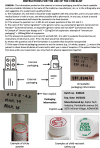A simplified checklist for the visual inspection of finished pharmaceutical products: a way to empower frontline health workers in the fight against poor-quality medicines
- PMID: 32377348
- PMCID: PMC7193355
- DOI: 10.1186/s40545-020-00211-9
A simplified checklist for the visual inspection of finished pharmaceutical products: a way to empower frontline health workers in the fight against poor-quality medicines
Abstract
Background: Substandard and falsified medicines, mainly prevalent in low and middle-income countries (LMICs), cause avoidable morbidity and mortality, and put at stake the performance of health systems. They may be prevented by an adequate implementation of pharmaceutical Quality Assurance (QA) guidelines, but unfortunately, most guidelines address upstream stakeholders and specialized staff in the supply chain. A multi-layered approach is needed, in order to empower the health workers at the point-of-care to proactively contribute to the fight against poor-quality medicines.Visual inspection is a simple technique, suitable for field screening. The findings of a survey conducted in the Democratic Republic of the Congo (DRC) suggested that it might be a fairly good (yet partial) predictor of poor-quality, when compared to full laboratory tests.
Methods and results: Starting from the 68-questions checklist originally used in the survey in the DRC, we developed a simplified checklist, specifically designed to guide health workers at the point of care to rapidly identify suspect poor-quality medicines. We selected those medicines' attributes the assessment of which does not require technical expertise, or access to regulatory information. Attributes were categorized according to a 3-level risk scale, to guide decision-making on suspect poor-quality medicines, based on an informed risk assessment.The simplified checklist contains 26 binary questions (YES/NO), grouped into four themes: packaging, identification, traceability, and physical appearance. Each non-conformity corresponds to a level of risk for patients. The user is guided towards three possible actions: A) reasonably safe for dispensing; B) dispense with explanation; C) quarantine and make a risk-benefit evaluation before dispensing.
Conclusion: The simplified checklist should now be implemented in real-life setting in LMICs. If proven useful in guiding health workers at the point-of-care to take rapid, transparent, patient-centred actions when facing a suspect poor-quality medicine, it could be further extended to address specific formulations. Digitalization for linkage with pharmacovigilance programs could also be considered.
Keywords: Developing countries; Falsified; Health workers; Medicines; Pharmacovigilance; Point of care; Post-marketing surveillance; Primary health care; Quality assurance; Substandard; Visual inspection.
© The Author(s) 2020.
Conflict of interest statement
Competing interestsWe declare no competing interests.
Figures
References
-
- World Health Organization. A study on the public health and socioeconomic impact of substandard and falsified medical products. Geneva; 2017. WHO/EMP/RHT/2017.02. Available: https://www.who.int/medicines/regulation/ssffc/publications/se-study-sf/en/. Accessed 20 Apr 2020.
-
- World Health Organization. (22–31 May 2017). Seventieth World Health Assembly. Annex A70/23. Appendix 3. Geneva, Switzerland. Available: https://www.who.int/medicines/regulation/ssffc/A70_23-en1.pdf?ua=1. Accessed 2 Sept 2019.
-
- World Health Organization. Norms and standards. 70 years of WHO standards on medicines quality. Expert committee on specifications for pharmaceutical preparations, 1947-2017: addressing changing public health challenges. Who Drug Info 2017. 2017;31(1):15–26. Available: https://www.who.int/medicines/publications/druginformation/issues/WHO_DI.... Accessed 20 Apr 2020.
LinkOut - more resources
Full Text Sources


